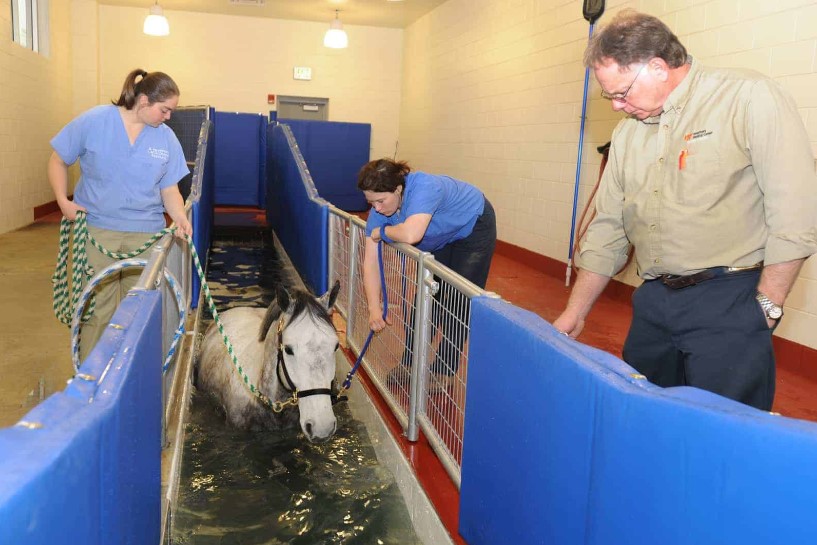Hydrotherapy and INDIBA: energy and water.
Published: 9 November, 2022
Marina Rodriguez Alonso | Veterinarian, master in equine physiotherapy | Global Brand Manager INDIBA Animal Health
A few weeks ago, we spoke about therapeutic exercises and their importance in rehabilitation and recovery from injuries. In recent years, hydrotherapy has become a key element in rehabilitation as an exercise protocol tool.What is hydrotherapy?
Hydrotherapy means water therapy and can refer to any therapeutic use of water to aid or improve health. When applied to animals, it may mean either swimming or walking in water, whether in shallow water along the beach, in a pool, or on an underwater treadmill. Other types of hydrotherapies also include the use of cold water or “spas”, that help the animals get relaxed. The focus of this article will be on exercises done on underwater treadmills or pools in the rehabilitation center and how the use of INDIBA combined with this therapy can be beneficial. Dog exercising on an underwater treadmill. Video from INDIBA Animal Health.What is hydrotherapy used for?
It is used to address the range of motion, proprioception, strength, neuromotor control, pain, and respiratory and cardiovascular resistance. Since it is a form of non-weight-bearing exercise, hydrotherapy can help treat a wide range of injuries and health conditions*. The low-impact nature of hydrotherapy exercise allows for its use in patients of all ages, from sound top performing athletes to improve their athletic conditions, to geriatric patients.Examples of those conditions are:- Musculoskeletal injuries or conditions
- Post-surgical healing and recovery**
- Neurological problems or any systemic disease that affects the musculoskeletal system or causes muscle atrophy
- Weight control
- Sport animals, to increase muscle power and cardiovascular resistance

Horse on an underwater treadmill. Photo property of the University of Tennessee.
Benefits of combining INDIBA and hydrotherapy
Like in therapeutic exercises, the benefits of applying INDIBA combined with hydrotherapy helps improve the results from the therapy due to its effects: pain reduction, improvement of blood flow, improvement of tissue flexibility, and reduction of repair time.Using it before or after going into the treadmill or in the pool will depend on the objectives of the therapy.Use it before to:- Prepare muscles for the exercise
- Increase flexibility and elasticity for a better range of motion
- Reduce pain to make the animal more comfortable
- Treat contractures or trigger points derived from the exercise
- Relaxation of muscles post-exercise
- Return to calm after a strong exercise session (especially in athletes)
From case study: Combined use of Monopolar Capacitive Resistive Radiofrequency (RFMCR) at 448 kHz and underwater treadmill in the conservative treatment of grade III medial patella dislocation: 4 clinical cases.Michela Arena. 2021[/profile] Check out our previous article on “Therapeutic exercises with INDIBA: go further” to find out about all the benefits of combining our technology with your exercise protocols.“The use of Monopolar Capacitive Resistive Radiofrequency in these patients has allowed us to reduce the pain and muscle spasm caused by patellar pathology (…); As a result, the patients were able to start a low-impact training on an underwater treadmill that focused on strengthening the muscles of the hindlimbs.”
*IMPORTANT: All rehabilitation protocols must always be supervised by a veterinarian or qualified professional. Hydrotherapy may be contraindicated in some patients.
References:
King, M. Principles and Application of Hydrotherapy for Equine Athletes. Available online: https://pubmed.ncbi.nlm.nih.gov/26898962/
Minguell Martín. Manual de Fisioterapia en Pequeños Animales. 2014.
Bauhaus, J. Hydrotherapy for Dogs: A Growing Trend in Canine Physical Therapy. 2020. Available online: https://www.akc.org/expert-advice/health/hydrotherapy-for-dogs-growing-trend-in-canine-physical-therapy/
An Introduction to Hydrotherapy Fact Sheet. Available online: https://vetspecialists.co.uk/fact-sheets-post/an-introduction-to-hydrotherapy-factsheet/
Equine hydrotherapy. Available online: https://www.horseandhound.co.uk/tag/equine-hydrotherapy#:~:text=Equine%20hydrotherapy%20uses%20water%20as,traditional%20cold%20hosing%20of%20limbs